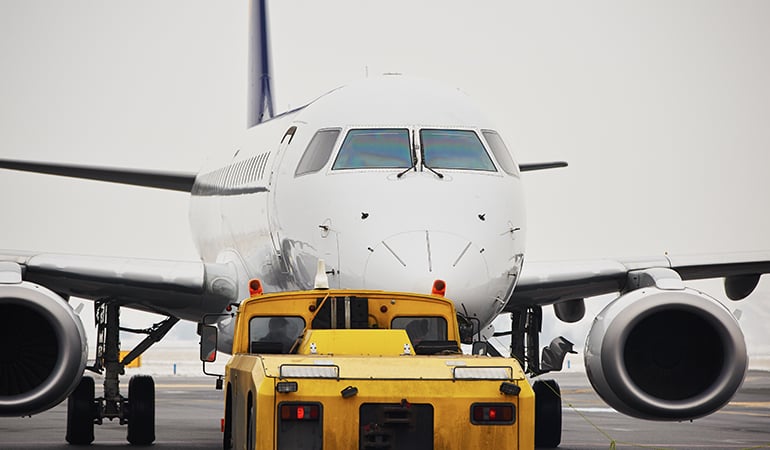Aircraft tugs are real modern marvels, moving aircraft weight hundreds of tons all day, every day. These movements come with very real risks every single time, and we are going to look at those now.
The apron of an airport is a really busy place, full of moving pieces of which any can do grave harm. Perhaps the most impressive maneuver is also the ground operation which has the most risk involved: aircraft ground movement, or aircraft towing and push-back. Private jets range anywhere from eight tons on the light side to nearly 50 tons for a fully loaded Gulfstream V. Airliners easily eclipse these figures, weighing several hundred tons when loaded. Aircraft tugs are very large, heavy, noisy animals; a Citation jet is a gazelle, the typical aircraft tug is a bull moose or water buffalo. In order to safely survive and thrive in this environment, we need to lay the groundwork of safe operating principles. Also, we’ll have a look at alternatives on the market which have the potential to significantly reduce risk associated with the procedure.
The Blueprint of a Good Tow Vehicle
As the old adage goes, you need to have the right tool for the job. Aircraft tugs are no exception to this policy at all; in fact, they may have been the reason for the adage in the first place! If you spend any time around the more rural airports, away from the hustle of hub airports, and you are going to find any and all manor of vehicles transcripted into tow duty.
The most popular piece of machinery to enlist into tow detail is the traditional farm tractor, and why not? Using extremely low gear ratios, a heavy steel frame, and robust connections and rigging, the farm tractor is a natural pick. Moreover, old farm tractors are never in short supply anywhere in the world. However, low gear ratios and high torque values are where the similarities end.
A great airport tug has to be really heavy. Ideally, an airport tug should weigh 10%-15% of the gross aircraft weight. Also, unlike other heavy industrial equipment, they should be low to the ground allowing a low center of gravity with a wide stance and ideally, a long wheelbase. The idea is to have a heavy, ultra-stable platform. Agriculture tractors do what they do really well, but they are not designed for the daily rigor of towing aircraft. Aircraft tugs are designed to do exactly what they do, and they do it really well. It is because they are designed for this singular focus that they are the safest tool for the job.
Operating an Airport Tug Safely
The basic premise of towing an airplane is not difficult to understand at all: hook it up to the airplane, release the brakes, tow to the desired location, and reverse the steps to dismount. But there are a lot of perils in the process. Traditional airport tugs use a tow bar which mounts to the tug and the airplane, generally somewhere on the nose landing gear assembly. These two mounting points offer ample opportunity to pinch off a finger or take a chunk of skin in the process.
Each aircraft has its own procedure for tow bar mounting and dismounting, but it usually entails attaching the tow bar to the airplane first, and then moving the tug into position and coupling it to the tow bar with either a drop pin or a pintle hitch. Either of these methods are serious pinch points and will smash a hand in an instant.
Diesel airport tugs are really interesting vehicles. They are often equipped with three steering modes to optimize efficiency and maneuverability while moving aircraft: standard front-steer, coordinated four-wheel steering, and then the crab steering, which allows a tow vehicle to move more lateral in nature. These are usually also four wheel drive vehicles, providing positive traction in any and all surface conditions which is good because they are often tasked with their work in the worst conditions. A big part of operating a tug safely is understanding how to operate the tug. Knowledge of operating systems, as well as operating capacities and limitations, is imperative in order to safely operate a tug.
Safe(r) Takes on Airport Tugs
Traditional aircraft tugs which use a tractor tug and a tow bar have proven to be very reliable and are still the primary tow tool for thousands upon thousands of operations every day. But they do come with a few very real disadvantages. First and foremost, the danger posed by connections and pivot points, and second, the learning curve associated with said tugs and tow bars.
There are a number of towbarless tugs on the market, which generally share a common mechanical concept of using a carriage and heavy hydraulic rams to cradle the nose landing gear tires of the aircraft and then lift them up. When the nose gear is lifted off the ground, the tug is able to maneuver far better than a tug and tow bar.
The design is still dependent on a whole complement of personnel for a towing operation, including a skilled driver for the tow vehicle. Also, many of the models are still powered by diesel engines which adds to noise pollution already prevalent to an airport ramp. Basically, these are a small net gain in that they remove the tow bar from the equation.
There are a few electric towbarless tugs on the market which are still driven by a tow vehicle operator seated on the unit. These are a better option than a diesel unit for some applications, particularly pushback where they can be connected quicker and more safely than a towbar, and the operator has a better visual picture for a pushback because they are located almost directly under the nose of the aircraft. The problem with this approach is that a manned airport tug still requires a supervisor and a separate driver who must be in communication with each other.
The Future of Safety
Two common features of all critical aircraft maintenance activities are: 1) communication between personnel, and 2) amount of personnel. You really want to minimize unnecessary personnel in most tasks, but especially anything involving fueling/defueling, open fuel lines, and aircraft ground operations and movement.
Aircraft towing involves moving a very heavy aircraft, which is also often quite wide, long, and tall. It is difficult-to-impossible to communicate fully safely with a tow team who are spread out across the aircraft, especially if the aircraft is operating an APU at the time, and even more so if there are running jet engines in the vicinity.
The problem is significant enough that NASA weighed in on it about four years ago. In fact, they went several steps further on the issue. They recognized that this is not just a safety issue, but a fuel waste issue, a carbon emissions issue, and a noise pollution issue.
Airport tugs are currently used most significantly in pushbacks from the gate and then whenever necessary for maintenance transit. But there are other issues which autonomous tow vehicles could almost immediately solve.
- In 2012, an estimated $7B was spent by airlines globally on fuel for aircraft to taxi to and from active runways to terminals, and vice versa. That’s Billion, with a B. Autonomous tugs will almost certainly be electric, which will cost almost incalculably minute amount of energy to charge compared to jet fuel use.
- A secondary cost to jet engine operation for simple taxiing operations is increased brake and tire wear, which is significantly lower than fuel use but will certainly add up over an entire fleet of aircraft.
- Less time running engines on the ground means less opportunity to ingest FOD, hence, less FOD damage to engines.
- If all aircraft are towed by autonomous tugs, there will be a significantly reduced threat of aircraft taxiing too fast, and aircraft taking incorrect turns (incursions), especially on airports which pilots are unfamiliar with. Or risk of aircraft taxiing too fast on wet surfaces, and driving in low visibility conditions. Since the autonomous tug will have human oversight and human override control, they can tow aircraft in conditions where aircraft-powered taxiing is unfavorable.
Conclusion to safety principles for aircraft tugs
The airport apron is a fast-paced, loud, messy environment. It is a flurry of activity rushing to make block times. In order to make sure that everyone goes home to their loved ones every night, safety rules and standard operating practices must be observed during all stages of maintenance, especially when it entails aircraft fueling or towing. However, aircraft towing is at the precipice of a technological revolution; the future of the practice looks to shift away from manually laborious and dangerous and instead embrace automation and the safety of removing the human element which is indisputably the most common culprit behind accidents and incidents. The technology is available now, and it is just a matter of time before it becomes the new standard.
Safety is important to you? To us, too! Get a free consultation and find out how you can reduce hazards on your apron.



Comments